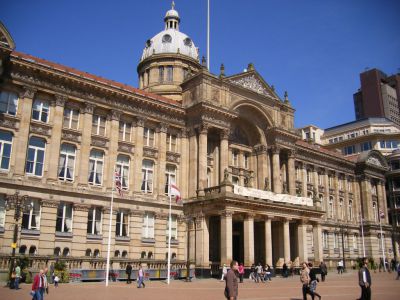
Council House, Birmingham
The Council House in Birmingham serves as the headquarters of Birmingham City Council and functions as the central hub for local government in the city. This Grade II* listed building not only houses the offices for council officers, including the Chief Executive, and elected members, but also features significant spaces like the council chamber, Lord Mayor's Suite, and an elaborate banqueting suite with a minstrel's gallery. The building is notable for its use of a first-floor exterior balcony by dignitaries and sports teams to address the public gathered below.
Constructed between 1874 and 1879, the building reflects the designs of architect Yeoville Thomason. It features a prominent hexastyle Corinthian porte-cochere leading to a balcony, arch, and tympanum, supported by a meticulously carved pediment. This construction was initiated to address the inadequacies of the earlier Public Office, dating from 1807, which was insufficient for the growing administrative needs of Birmingham, particularly after its status elevation to a city in 1889.
The main façade facing Victoria Square is adorned with a mosaic in the tympanum by Salviati Burke and Company of Venice, above which sits a pediment depicting Britannia receiving Birmingham's manufacturers. The square itself holds historical significance, having been the site of Christ Church before its demolition in 1899.
After its initial construction, the Council House was extended from 1881 to 1885 to add the city's art gallery, museum, and Gas Department offices, funded innovatively by the Gas Department to bypass taxpayer funding limits for the arts. Additional expansions from 1911 to 1919 included a new northern block linked by a corridor similar to Venice's Bridge of Sighs, which now contains the Feeney Art Galleries.
The Council House has also been a focal point for significant civic celebrations, such as the illumination event for the coronation of King Edward VII and Queen Alexandra in 1902, underscoring its role not just as a functional space for governance but as a symbol of local pride and heritage.
Constructed between 1874 and 1879, the building reflects the designs of architect Yeoville Thomason. It features a prominent hexastyle Corinthian porte-cochere leading to a balcony, arch, and tympanum, supported by a meticulously carved pediment. This construction was initiated to address the inadequacies of the earlier Public Office, dating from 1807, which was insufficient for the growing administrative needs of Birmingham, particularly after its status elevation to a city in 1889.
The main façade facing Victoria Square is adorned with a mosaic in the tympanum by Salviati Burke and Company of Venice, above which sits a pediment depicting Britannia receiving Birmingham's manufacturers. The square itself holds historical significance, having been the site of Christ Church before its demolition in 1899.
After its initial construction, the Council House was extended from 1881 to 1885 to add the city's art gallery, museum, and Gas Department offices, funded innovatively by the Gas Department to bypass taxpayer funding limits for the arts. Additional expansions from 1911 to 1919 included a new northern block linked by a corridor similar to Venice's Bridge of Sighs, which now contains the Feeney Art Galleries.
The Council House has also been a focal point for significant civic celebrations, such as the illumination event for the coronation of King Edward VII and Queen Alexandra in 1902, underscoring its role not just as a functional space for governance but as a symbol of local pride and heritage.
Want to visit this sight? Check out these Self-Guided Walking Tours in Birmingham. Alternatively, you can download the mobile app "GPSmyCity: Walks in 1K+ Cities" from Apple App Store or Google Play Store. The app turns your mobile device to a personal tour guide and it works offline, so no data plan is needed when traveling abroad.
Council House on Map
Sight Name: Council House
Sight Location: Birmingham, England (See walking tours in Birmingham)
Sight Type: Attraction/Landmark
Guide(s) Containing This Sight:
Sight Location: Birmingham, England (See walking tours in Birmingham)
Sight Type: Attraction/Landmark
Guide(s) Containing This Sight:
Walking Tours in Birmingham, England
Create Your Own Walk in Birmingham
Creating your own self-guided walk in Birmingham is easy and fun. Choose the city attractions that you want to see and a walk route map will be created just for you. You can even set your hotel as the start point of the walk.
Birmingham Introduction Walking Tour
The word Birmingham derives from the Old English term "Beormingas." A Beorminga was a person who was one of "Beorma's people." Who was Beorma? Who knows? Something was always stirring around Birmingham.
In 1166, Peter de Bermingham received a charter from the King, Henry II, to build a market at his castle (Peter's castle, not Henry's). As Lord of the Manor... view more
Tour Duration: 2 Hour(s)
Travel Distance: 3.2 Km or 2 Miles
In 1166, Peter de Bermingham received a charter from the King, Henry II, to build a market at his castle (Peter's castle, not Henry's). As Lord of the Manor... view more
Tour Duration: 2 Hour(s)
Travel Distance: 3.2 Km or 2 Miles
Birmingham Historical Buildings Tour
Although existent as a settlement since the early 7th century AD, Birmingham, UK is a relatively young city that has grown rapidly, as a result of the Industrial Revolution, from the 18th century onward. Thus, the local architecture is overwhelmingly a product of the 18th, 19th, and 20th centuries, with little survived from the earlier days.
Traces of the ancient settlement, dating back to... view more
Tour Duration: 2 Hour(s)
Travel Distance: 3.6 Km or 2.2 Miles
Traces of the ancient settlement, dating back to... view more
Tour Duration: 2 Hour(s)
Travel Distance: 3.6 Km or 2.2 Miles


